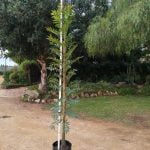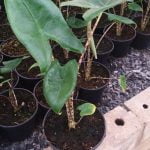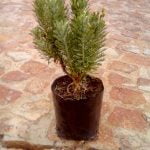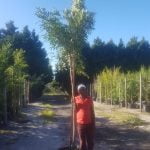Showing 769–780 of 816 resultsSorted by popularity
-
Sale!

Tecoma Capensis 10lt Orange
All Plants, Full Sun Plants, Hedging Plants, Indigenous Plants, Semi Shade Plants, Water Wise PlantsOriginal price was: R250.00.R150.00Current price is: R150.00.Add to cartTecoma Capensis 10lt Orange
Common Name: Cape Honey SuckleFull Sun
Afternoon Sun
Low Watering
Evergreen -
Sale!

Tecoma Capensis 10lt Big Red
All Plants, Full Sun Plants, Hedging Plants, Indigenous Plants, Semi Shade Plants, Water Wise PlantsOriginal price was: R250.00.R180.00Current price is: R180.00.Add to cartTecoma Capensis 10lt Big Red
Common Name: Cape Honey SuckleFull Sun
Afternoon Sun
Low Watering
Evergreen -
Sale!

Dovyalis Caffra Tree (Kei Apple) 20lt
All Plants, Full Sun Plants, Hedging Plants, Indigenous Plants, Semi Shade Plants, Water Wise PlantsOriginal price was: R550.00.R350.00Current price is: R350.00.Add to cartDovyalis Caffra Tree 20lt
Common Name: Kei AppleFull Sun
Semi Shade
Evergreen
medium Watering
Indigenous
Hedging PlantDovyalis caffra, commonly known as the Kei Apple or Kaffir Plum, is a small to medium-sized tree native to southern Africa. It belongs to the Flacourtiaceae family. The Kei Apple is valued for its edible fruits and is also cultivated as an ornamental plant.
Appearance: The Kei Apple is an evergreen tree with a dense, rounded crown. It can grow up to 4-6m in height and has thorny branches.
Leaves: The leaves are glossy, dark green, and elliptical in shape, with prominent veins. They are often serrated or toothed along the edges.
Flowers: The tree produces small, inconspicuous, and greenish-yellow flowers that are not particularly showy. They are typically dioecious, meaning male and female flowers are borne on separate trees.
Fruits: The Kei Apple is most known for its plum-sized, round to ovoid fruits, which are edible and have a sweet and tangy flavour. The fruits ripen to a yellowish colour when fully mature and can be eaten fresh or used to make jams, jellies, and sauces.
Growth Requirements: Dovyalis caffra prefers well-draining soil and can tolerate a range of soil types. It grows best in full sun but can also tolerate partial shade. The tree is relatively drought-tolerant once established, but regular watering can help improve fruit production.
Wildlife Attraction: The fruits of the Kei Apple are not only enjoyed by humans but also attract birds and other wildlife, making it a valuable addition to gardens and landscapes that support local biodiversity.
Uses: Apart from its culinary uses, the Kei Apple is sometimes used as a hedge or barrier plant due to its thorny nature. In some regions, the tree is also used for erosion control.
-
Sale!

Ekebergia Capensis 20lt
Original price was: R550.00.R399.99Current price is: R399.99.Add to cartEkebergia Capensis 20lt
Common Names: Cape Ash, Dogplum, EssenhoutFull Sun
Low Watering
Indigenous
Evergreen
Drought Tolerant When EstablishedEkebergia capensis, commonly known as the Cape ash or African ash, is a tree species native to South Africa.
Habitat: Ekebergia capensis is found in various parts of South Africa, including the Cape Peninsula, Eastern Cape, KwaZulu-Natal, Mpumalanga, and Limpopo. It typically grows in woodland and forest habitats, often near rivers or in moist areas.
Description: It is a medium-sized to large deciduous tree that can reach heights of up to 20 meters. The tree has a dense, rounded crown and a straight trunk. The bark is greyish-brown and becomes rough and fissured as the tree matures. The leaves are compound, with leaflets arranged in pairs, and they are shiny dark green in colour.
Flowers and Fruits: Ekebergia capensis produces small, creamy-white flowers in dense clusters. The flowers are fragrant and attract bees and other insects for pollination. After pollination, the tree develops small, round fruits that turn purple when ripe. The fruit contains a single seed and is edible, but not commonly consumed by humans.
Uses: Ekebergia capensis has several uses in traditional medicine and cultural practices. Various parts of the tree, such as the bark, leaves, and roots, are used for their medicinal properties. The wood is durable and used in construction, furniture making, and for fuel. The tree also has some cultural significance and is often planted as an ornamental tree in gardens and public spaces.
Conservation status: Ekebergia capensis is not currently listed as a threatened species. However, like many tree species, it can face threats from habitat loss, deforestation, and invasive species. Conservation efforts are important to preserve the natural habitats where this tree species occurs.
-

Alocasia Zebrina 14cm Pot
R275.00Add to cartAlocasia Zebrina 14cm Pot
Water well when needed.
Loves bright sunlight but not direct sun on the leaves or they will burn.
Turn weekly to prevent stems from growing towards to the sunlight. -
Sale!

Delicious Monster 19cm Pot
Original price was: R375.00.R195.00Current price is: R195.00.Add to cartDelicious monster 19cm Pot
-

-
Sale!

Euryops Silver Sunshine 15cm
Original price was: R95.00.R85.00Current price is: R85.00.Add to cartEuryops Silver Sunshine 15cm
Common Name: Silver Daisy, Resin bushFull Sun
Indigenous
Medium Watering
Evergreen
Drought ResistantSilver-green shrub that grows to about 1m in height with yellow daisy-like flowers. They flower nearly all year round
-

Buddleja Saligna 70lt
70lt Trees, All Plants, Full Sun Plants, Hedging Plants, Indigenous Plants, Semi Shade Plants, Water Wise PlantsR2,450.00Add to cartBuddleja Saligna 70lt
Buddleja saligna, commonly known as the False Olive or White Olive, is a species of flowering shrub or small tree belonging to the Buddlejaceae family. It is native to southern Africa, specifically found in countries such as South Africa, Mozambique, and Zimbabwe.
Appearance: The False Olive is a fast-growing evergreen shrub or small tree that can reach heights of about 5 to 10 meters. It has a dense, rounded canopy and pendulous branches.
Leaves: The leaves are lance-shaped or elongated, measuring around 5-12 cm in length. They are dark green on the upper side and have a silvery or greyish appearance on the lower side.
Flowers: The shrub produces fragrant, small, tubular, creamy-white flowers that are arranged in slender, elongated clusters. These flower clusters can be quite attractive to butterflies and other pollinators.
Fruit: After flowering, Buddleja saligna develops small, woody capsules containing tiny seeds.
Habitat: The False Olive is well-adapted to a variety of habitats, from coastal areas to rocky slopes and open woodlands. It is also common in disturbed areas and can be considered a pioneer species.
Uses: In some regions, Buddleja saligna has been used for various purposes. For example, the wood is occasionally used for furniture, and the leaves and bark have traditional medicinal uses. The plant is also valued for its role in attracting wildlife, particularly butterflies and birds, making it a popular choice in gardens and landscapes for biodiversity and wildlife conservation.
-

Syzygium Guineense 70lt
70lt Trees, All Plants, Full Sun Plants, Hedging Plants, Indigenous Plants, Semi Shade Plants, Water Wise PlantsR2,450.00Add to cartSyzygium Guineense 70lt
Common Name: Waterpear TreeFull Sun
Indigenous
Evergreen
Low Watering
Hedging Tree
Drought Tolerant
Wind TolerantSyzygium guineense, commonly known as Waterberry, Water Pear, or African Waterpear, is a species of tree belonging to the Myrtaceae family. It is native to various regions in Africa, including parts of West Africa, East Africa, and southern Africa. The Waterberry tree is valued for its edible fruits and is often found growing near water sources, such as rivers and lakes.
Appearance: Syzygium guineense is a medium-sized to large tree that can reach heights of 10 to 30m. It has a rounded crown with dense foliage.
Leaves: The leaves of the Waterberry tree are simple, opposite, and elliptical in shape. They are dark green and have a glossy appearance.
Flowers: The tree produces small, cream-colored or white flowers that are arranged in panicles or clusters. The flowers are usually not showy but are an important source of nectar for pollinators.
Fruits: The most significant feature of Syzygium guineense is its edible fruit, which is known as Waterberry or Water Pear. The fruits are small, round, and turn from green to purple-black when ripe. They have a sweet and slightly tart flavour and are enjoyed fresh or used to make jams, jellies, and beverages.
Growth Requirements: Waterberry trees prefer well-draining soil and are commonly found growing in areas with access to water, such as riverbanks and wetlands. They can tolerate both full sun and partial shade.
Uses: The fruits of Syzygium guineense are an important food source for both humans and wildlife, including birds and various mammal species. In some regions, the bark and leaves of the tree have also been used for medicinal purposes.
Wildlife Attraction: The Waterberry tree is attractive to birds and other wildlife, which feed on its fruits and disperse its seeds, contributing to its ecological significance.
-

Ilex Mitis 70lt
R2,450.00Add to cartIlex Mitis 70lt
Full Sun
Evergreen
Indigenous
Medium Watering
Wind TolerantIlex mitis, commonly known as the Cape Holly or Cape Holly Tea, is a species of evergreen tree or shrub in the family Aquifoliaceae. It is native to various regions in Africa, including South Africa, Zimbabwe, and Mozambique. The Cape Holly is valued for its ornamental qualities, as well as its use in traditional medicine.
Appearance: Ilex mitis is a small to medium-sized tree or large shrub that can reach heights of 5 to 10m. It has a dense, rounded canopy with glossy, leathery leaves.
Leaves: The leaves of the Cape Holly are simple, alternate, and elliptical to oblong in shape. They have a dark green colour and smooth margins. The leaves are often used to make a caffeine-free herbal tea, known as Cape Holly Tea or Kaffer tea, which is popular in South Africa.
Flowers: The tree produces small, inconspicuous flowers that are typically greenish-white in colour. The flowers are not showy and are borne in clusters.
Berries: After flowering, Ilex mitis produces small, round berries that are initially green and turn red or black when mature. The berries are not edible and are considered toxic.
Medicinal Uses: In traditional African medicine, various parts of Ilex mitis, including the leaves and bark, are used for their potential medicinal properties. Cape Holly Tea is particularly known for its use in treating various ailments, including colds, coughs, and digestive issues. It is also believed to have mild diuretic properties.
Wildlife Attraction: The Cape Holly tree is attractive to birds and other wildlife, which feed on its berries and help disperse its seeds.
Growth Requirements: Ilex mitis prefers well-draining soil and grows best in full sun to partial shade. It is relatively drought-tolerant once established and can tolerate a range of soil types.
-

Ekebergia Capensis 70lt
70lt Trees, All Plants, Full Sun Plants, Hedging Plants, Indigenous Plants, Semi Shade Plants, Water Wise PlantsR2,450.00Add to cartEkebergia Capensis 70lt
